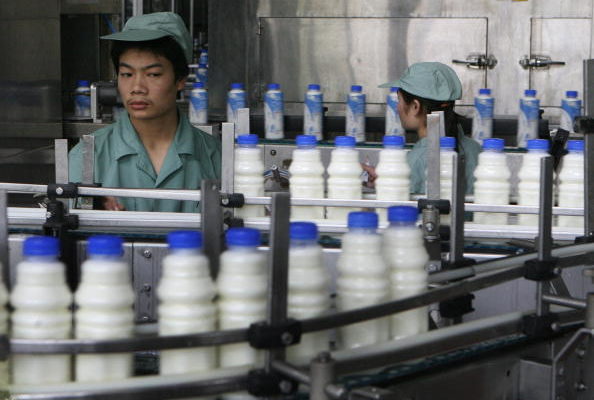In recent years, the dairy industry in mainland China has been expanding continuously. However, due to declining birth rates, slowing economic growth, and consumers tightening their purse strings, the demand for milk has decreased. This has led to an oversupply of milk in China, forcing smaller dairy farms to shut down and squeezing the shipment volumes of China’s dairy market to countries around the world.
According to a report by Reuters on September 20th, the milk surplus in China highlights Beijing’s drive for food safety, aiming to boost the dairy industry by encouraging consumption and expansion. High production costs and the tainted milk scandal of 2008 have also made it difficult for China to boost milk exports.
In 2018, as part of a broader initiative to promote self-sufficiency in food production, the Beijing government called for the establishment of more dairy farms and increased milk production. The dairy industry in China grew rapidly, with a surge in farms and the import of hundreds of thousands of Holstein cattle.
However, since the outbreak of the pandemic, China’s economy has been struggling, weakening the demand for high-priced dairy products such as cheese, butter, and cream. Coupled with an aging population, milk consumption in China dropped from an average of 14.4 kilograms per person in 2021 to 12.4 kilograms per person in 2022, according to the latest data provided by the National Bureau of Statistics of China.
Meanwhile, as the world’s third-largest producer of milk, China’s milk production increased from 30.39 million tons in 2017 to nearly 42 million tons last year, surpassing Beijing’s target of 41 million tons by 2025.
Since 2022, milk prices in China have fallen below the average production cost of approximately 3.8 yuan (0.5352 USD) per kilogram. According to the May 2024 Monthly Report on Supply and Demand of Fresh Agricultural Products published by the Ministry of Agriculture and Rural Affairs of China, the domestic surplus situation for raw milk continues, with raw milk acquisition prices declining year-on-year for 27 consecutive months, marking the longest decline since 2010.
According to a report by Huxiu, a dairy farmer named Zhang Ming from Henan province expressed, “In recent years, our farm has been supplying milk to large dairy companies, and the latest price we received for milk was only 3 yuan per kilogram, compared to 3.4 yuan per kilogram earlier this year.”
The drop in prices has led to the closure of many loss-making dairy farms. Other farms are reducing their livestock by selling cows for beef, as the beef market in China is also facing oversupply issues.
One of China’s major producers, Modern Dairy, reported that the inventory of their dairy cows decreased by half in the first half of this year, with a net loss of 207 million yuan (approximately 29.07 million USD).
Li Yifan, managing director of StoneX Dairy Products (Asia), stated, “Dairy farming companies are experiencing losses both in selling milk and selling meat.”
Zhang Ming admitted, “When expanding the farm, I invested a significant amount in the facilities and cows. With the current downward trend in cattle prices, if I exit the industry now, the losses will be substantial. So, I have no choice but to persevere and wait for the industry to overcome this difficult period.” Another dairy farmer, Li He from Wenzhou, mentioned that the entire farm is currently operating at a loss due to prices dropping to levels seen several years ago.
Customs data from China shows that in the first eight months of this year, the import volume of dairy products (mainly from New Zealand, the Netherlands, and Germany) decreased by 13% to 1.75 million tons, with milk powder imports dropping by 21% to 620,000 tons.
In a report last month, Rabobank predicted a 12% decrease in net dairy imports in 2024 compared to the previous year, stating that the extension of the downturn in the dairy market could continue to affect import volumes in 2025.
Apart from the economic slowdown, declining birth rates in China also mean a reduced number of infants requiring formula milk. In 2023, China’s birth rate hit a historic low.
New Zealand’s A2 Milk Company sells infant formula in China. The company reported in August that in the 2024 fiscal year up to June, the quantity and value of infant formula in the Chinese market declined by 8.6% and 10.7%, respectively, with a further decline expected in 2025.
Liquid milk accounts for 80% of dairy consumption in China. In 2018, Beijing aimed to shift consumer habits from drinking milk to “eating milk,” thereby increasing dairy consumption and developing markets for cheese, butter, and cream, to transform milk into higher-value, longer-shelf-life products. However, due to consumers tightening their belts, this effort has been hindered.
The China Dairy Association stated that to control surplus production, Chinese producers are converting raw milk into milk powder. By the end of June, the surplus volume had exceeded 300,000 tons, roughly twice the level of the previous year.
Li from StoneX mentioned that China is also attempting to export full-fat milk powder, but faced with lingering concerns over adulteration scandals, exports are restricted. Additionally, many Chinese consumers prefer foreign brands.
In the first half of 2024, China’s dairy product export volume reached 55,100 tons, an 8.9% increase year-on-year, but only a small portion of the trade surplus.
According to calculations by StoneX, Chinese dairy farmers heavily rely on expensive animal feed, meaning production costs are nearly double those of leading exporter New Zealand, where cows graze on pastures.
The domestic oversupply situation has not been adequately addressed by attempts in China-EU trade disputes to curb the import of European cheeses, milk, and butter into China.
Tanya Bhatia, a consumer goods research analyst at The Economist Intelligence Unit, stated, “While restricting EU dairy imports may provide short-term relief to Chinese pastoralists, it does not solve deeper issues such as overproduction and stagnating demand.”

